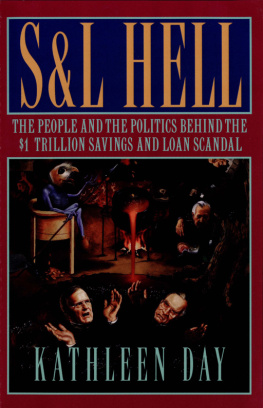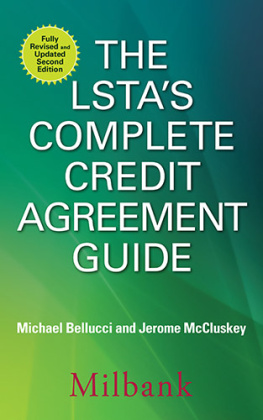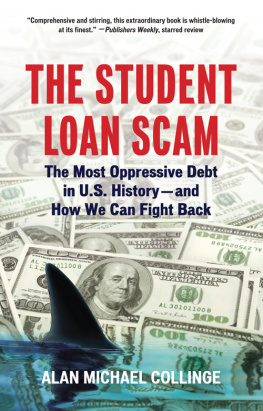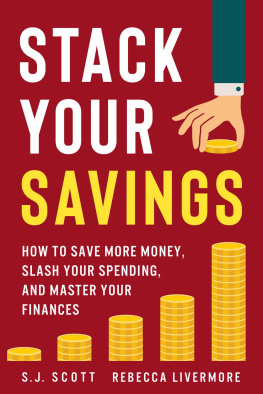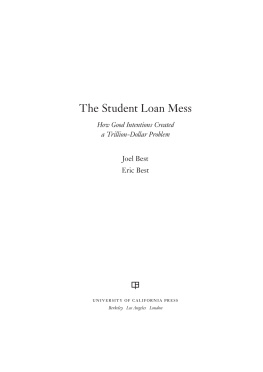S&L HELL
S&L HELL

Copyright 1993 by Kathleen Day
All rights reserved
FIRST EDITION
Book design by Susan Hood
Library of Congress Cataloging-in-Publication Data
Day, Kathleen, 1953
S & L hell : the people and the politics behind the $1 trillion
savings & loan scandal / by Kathleen Day.
p. cm.
Includes bibliographical references and index.
1. Savings and loan associationsUnited StatesCorrupt practices. 2. Savings and loan associationsUnited States
Deregulation. 3. United StatesEconomic conditions1981
I. Title. II. Title: S and L hell.
HG2151.K63 1993
ISBN: 978-0-393-24249-2 (e-book)
W. W. Norton & Company, Inc., 500 Fifth Avenue, New York, N.Y. 10110
W. W. Norton & Company Ltd., 10 Coptic Street, London WC1A 1PU
Epilogue
Copyright 1990 Robinson/Quiroz. Lyrics used by permission
19. Into the Breach
Kermit L. Mowbray was president of the Topeka regional bank.
To Charles
and to my parents
and to Rebecca
Contents
The savings and loan debacle is the costliest scandal in the countrys history. Bailing out the S&L industry will cost taxpayers at least $500 billion over the next few years and more than $1 trillion over the next several decades, once the cost of borrowing the money is added. Thats more than $4,000 for every person in the United States, an amount that is equal to several times the governments deficit.
How could such a catastrophe have occurred? Some sort of shake-out in the industry was inevitable; by 1980 the day of the mom-and-pop thrift immortalized in Frank Capras Its a Wonderful Lifethe film whose heroic portrayal of an S&L executive has become painfully easy to parodyhad passed. But the industry fell far harder (and far more expensively) than it had to.
In fact, the most remarkable thing about the collapse of the S&L industry is that so many of the major participantsthe regulators, politicians, and S&L operators themselveschose to do nothing as they watched problems mount and taxpayer liabilities grow. That choice was dictated by a variety of motives: greed, political self-interest, and even (sometimes) misguided good intentions. Whatever the motives, this collective interest in hiding the debacle made it certain that the industrys final fall would come with an enormous bang, one that would force administrations that professed a free market philosophy essentially to nationalize a majority of the nations thrifts. As a result, the industry in many respects became one of the best examples of socialism in the U.S. economy.
Throughout the book, readers will find examples of an economic phenomenon in which a borrower gets so far in default that the lender has no choice but to throw good money after bad in the hope the debtor will one day recover and repay his debts. In this case the debtor is the thrift industry, borrowing on the good name of the U.S. government.
Other treatments of the S&L crisis have offered a range of explanations for the industrys problems: the influence of organized crime, a conspiracy on Wall Street, imperfections in the market, and so on. All of theseto which, perhaps, the roles of greed and ambition should be addedmay have played some part. But while the temptation is great to offer the debacle as a paradigm for the failures of regulation, this book doesnt advance a grand theory. Instead it tells the history of the scandal through the stories of the principal players. It is a history sadly lacking in heroes. If there are some obvious lessons for the future to be learned from these stories, Ive left them for the reader to draw.
I sincerely believe that banking establishments are more dangerous than standing armies.
Thomas Jefferson
A nations economy cannot be healthy when a basic element in it is sick.
Wall Street financier Bernard M. Baruch shortly before the 1929 crash
Thats where the money was.
Willie Sutton, when asked why he robbed banks


T he secret of life is honesty and fair dealing. If you can fake that, youve got it made.
Groucho Marx
M arch 14, 1985: A balding six-foot-seven-inch man sat scrunched in his seat as the United Air Lines jet taxied for takeoff from San Francisco International Airport. Suddenly a message over the intercom made the passenger even more uncomfortable. We have to return to the terminal, the pilot said. Theres some guy on this flight named Volcker and he has a phone call. So much for the anonymity sought by Federal Reserve Board Chairman Paul Volcker.
Volckers staff in Washington, D.C., agonizing over whether to recall the flight, felt they had no choice. Trouble was brewing in Ohio. Shock waves were washing through the Midwest and the world. Two weeks earlier, on March 4, the Securities and Exchange Commission (SEC) had closed down a small, fraud-ridden government securities dealer in Fort Lauderdale, Florida, E.S.M. Government Securities. The action had a domino effect.
E.S.M. owed millions of dollars that it could not pay to Home State Savings Bank of Cincinnati, and the losses might be fatal to the Ohio thrift. When the Cincinnati Enquirer broke news of Home States losses on March 6, lines of depositors formed outside the thrift in a run that threatened to spread to other institutions. Depositors had panicked on news that Home State could fail and that its collapse threatened to deplete the $130 million Ohio Deposit Guaranty Fund, an industry-financed and -operated but state-regulated fund that covered deposits at seventy of Ohios three hundred thrifts. Though the funds name and seal gave the impression it was backed by the full faith of the Ohio treasury, it was not.
If the panic continued, it could spread beyond Ohio, upsetting an already fragile banking system, one rocked a year earlier by the $4.5 billion federal bailout of banking giant Continental Illinois of Chicago.
The American dollarwhich had been climbing despite the best efforts of Volcker and Treasury officials to keep it down, making American goods more expensive around the worldfell overnight on the news of Ohios problems. The tumble was a classic sign of anxiety among investors, fearing for the safety and security of the U.S. banking system. One of Volckers jobs was to help maintain public confidence in the system. What if people couldnt take their money out of Home State when they asked for it? Who knew how many other panics might result? The reputation of the United States as a benchmark of financial security worldwide could evaporate, spreading havoc throughout the world. That prospect, no matter how remote, simply would not do.
With such thoughts in mind, the Federal Reserve Boards chief counsel, Michael Bradfield, dialed the White House switchboard and described the emergency to one of its operators. In seconds she patched him through to officials at United Air Lines headquarters in Chicago, who summoned the planes return. Back in the terminal Volcker telephoned his staff to learn that Ohio Governor Richard Celeste, with a full-blown emergency on his hands, had threatened to fly to Washington and camp out on the Feds doorstep if he couldnt talk to Volcker. Depositor runs on savings and loans in Ohio indeed were spreading, and Celeste was about to declare the first broad bank closure since President Roosevelts bank holiday in 1933 during the Great Depression. Knowing the decision would be the toughest of his career, Celeste wanted to inform Volcker personally and enlist the Feds support.
Next page
